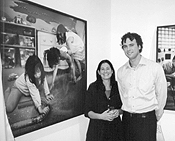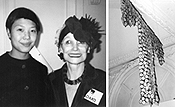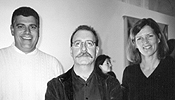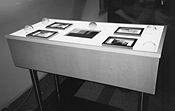| content | about | pitch | subscribe | find | advertise | mouthoff |
| blinddate
november 9, 2003: after a yearlong experiment in the art of patronage, hyde park art center unveils the fruits of its matchmaking labors with not just another pretty face. m2m plays third wheel as the collectors reunite with their chosen artists, and view their commissions for the very first time. photos by liz nielsen |
 Tatum, Reese, and Janis, 2003; Janis and Ben |
Patrons: Janis Kanter and Tom McCormick Occupations: Mom (Janis); Gallery owner (Tom) Artist: Ben Gest Commission: Tatum, Reese, and Janis, archival inkjet print, 40x40 in., 2003 Let's start off with you, Ben. Sum up your principal artistic concerns. The art I make expresses my thoughts about personal relationships among families, married couples--people who are close. I'm interested in the struggle between people as they live together, spend time close to each other, and work out their own ideas of who they want to be in relationship to somebody else. Are you an active collector, Janis? Both my husband and I are, but we've never collected photography. I always wanted to, but Tom, who's a painting dealer, would never let me! (laughs) So this seemed to be the golden opportunity--photography with my children in it. He couldn't say no. Right--you can't turn that down! What struck you about Ben's work? Well, we came down here to talk with HPAC about their programming, and they showed me some of Ben's work. I just loved it--his domestic scenes seemed really elegant; they were magnetic and beautiful. Then we learned about this project, and that Ben was part of it. I was wondering if he would photograph my kids, because I never wanted to do studio portraits of my children--it seems very lame and boring. Ben agreed to come over and discuss it, and he said, "Well, it's new for me, but that's the challenge. The whole point of this idea of a commission is to push yourself." Actually, he was much calmer about handling it than I was. So he came over one day to see the kids and get an idea of the place. Then, when we moved to the actual photography, he told me to leave! He kicked you out? Yeah! But I understood why. Our children were so young that it was going to be hard enough to get them to focus, and I would have been a distraction. What was the process like for you, Ben? What challenges did you face, and what inspiration did you take from what you saw in their home? Well, there's probably a point when I couldn't have done this; in the past, my ideas were generated much more by knowing the people I was photographing. But as my work has developed, it has become a lot easier to photograph someone I've never seen before. I still have certain kinds of pictures I'm trying to make, so in this case, I wasn't so much thinking about how Tatum relates to Janis, or how Tatum relates to Reese. I had ideas of what I wanted before I even saw them; then it was just a matter of figuring out how they fit into those ideas. Aside from getting thrown out of the room, Janis, what other insights did you gain into Ben's process? I understood going in that Ben had an ability to manipulate numerous photos, and work them into a domestic scene that seemed as though it had happened in that moment. But it's only in hindsight now--recognizing who was in the room when, and seeing the whole thing put together--that I really grasp the beauty of what he's creating. And I was amazed at the amount of rolls he shot. After the first session, I asked Tatum if she'd had fun, and she said, "No. It was really hard and boring!" But it's an amazing process, and one that I think is unique to Ben, so I'm very impressed. Did he capture anything about your family that surprised you? Well, we were getting ready to move, so one thing that was really important to me was documenting the girls in their room, because it was their first home. It might not have been the first choice for Ben, but ultimately he decided that room would work. I think he really captured the way I feel about my kids. I'm an artist by trade; I used to do my work and then I gave it up, and now I take care of my children. They're my artistic outlet. Even though the photograph was shot over several moments, it appears to be a moment in our life. And in fact, it is--it's a regular day for us. Would you work on commission again, Ben? If people are willing to allow me to work with them in the way I'm interested in working, then yeah. It would seem to require a lot of trust on the part of your subjects. It's all about trust. With photography there's this expectation of reality, and I think there's a fear people carry around about how they're going to be revealed. It's a strange thing to let go of your image, but it requires that. I think the people involved in commissioning works for this show understand art, so they understand the difference between a photograph and its depiction of reality. That made it easier. So Janis, do you have a place picked out for this piece? I do; it's going to be prominently displayed in the family room of our new house--so Ben will be excited when he comes over. The neat thing about a commission is that it allows you to feel a closeness to someone you wouldn't necessarily get to feel. I don't see Ben sailing off into the horizon and never hearing from him again. Sounds like you're getting a free dinner sometime soon, Ben. If I'm invited, I'll definitely show! |
 Left to right: Cat and Deone; Caged, 2003 |
Patron: Deone Jackman Occupation: Retired psychotherapist Artist: Cat Chow Commission: Caged, copper and plastic, 58x52x3 in., 2003 Cat, sum up your major artistic concerns. I create my own fabrics to make sculptural garments. Are you an active collector, Deone? Yes, for as long as I've been able to collect anything! I'm also Chair of the Hyde Park Art Center Board. Do you have a particular aesthetic, when it comes to your collection? Deone: Well, Cat has seen it... Cat: It's definitely a wide and diverse collection, but there's an elegance, a minimalism, which I drew upon, and which I also like to create in my own works. What led you to commission Cat? I saw a show of hers, and I thought the work was absolutely wonderful. So when we set up the whole idea for this project, and I saw Cat's name on the list, I immediately said, "I want her!" As the Board chair, I didn't know if I should do that; I thought maybe I was being greedy. Well, first come, first served! Right! What insights did you gain from being Cat's patron? Well, first of all, we met at Cat's apartment, and I was pleased to be able to visit her home and work space. One of the joys of working with artists in this way is that you can get to know them and develop relationships. Talk about the process of making work on commission. Cat: Well, you obviously want to be pleased with the work, as well as with the person you make it for. Deone gave me a lot of liberties; all she said was that she would like it to be in kimono form. Deone: I didn't want to dictate at all, but I wanted the work to be somehow reflective of me. So I asked Cat to go see the Jin Soo Kim show at the Cultural Center, because I like her work very much, as well. Cat: And I found her work very inspirational. That's maybe where the copper wire, and the multiple use of objects, came from. Deone: Cat also came to my house, and I told her to feel free to look at everything. She walked around our apartment; then I asked her if she'd seen enough, and she said yes. We haven't seen each other again until today. So what's your response to Cat's piece, Deone? I think it's exquisite. I'm just knocked out. I would say it's the most beautiful piece of hers I've seen. Will you wear it? I didn't commission it to wear, although I'm not sure I won't. I don't know. First of all, I have to find out what it feels like! Have you chosen a place in your house to hang it? Yes; it's going in our bedroom. Weeks and weeks ago, I cleaned out a corner for it, but now I'm not sure it's going to be enough space. I'll have to measure the width of those sleeves! |
 Lois, left, and Jackie with Seascape at Iowa, 2003 |
Patron: Lois Iseminger Occupation: Self-employed Artist: Jackie Kazarian Commission: Seascape at Iowa, acrylic, watercolor, gouache, oil, flock, and wallpaper on paper, 29-1/2x29-1/2 in., 2003 So Lois, are you an active collector? Yes, since the early 1980s. Basically, I'm attracted to contemporary art in all media. What led you to commission Jackie? I first saw her work in the slide presentations at the start of this project--unfortunately, I was not aware of her work before that time. But I was especially intrigued by her use of wallpaper. What was it like working on this project? Jackie: Well, I anticipated maybe having some restrictions placed on me by her desires or expectations, but at the very beginning she said, "Do whatever you feel like doing." So I had an open book, which I wasn't expecting. Then we talked a lot about her life, and she has this really rich history--she grew up on a farm in Iowa, and we talked about those spaces. I also made documentary photographs of significant items in her life, and a lot of them came from her past: her mother made Punch and Judy dolls, and Lois has this amazing little spoon collection. So she had a lot of interesting stories about those items, as well as about her responses to contemporary art, and why she was collecting. Eventually, though, the piece came out of our discussion not about things, but about the joy of large spaces. Lois: I was very impressed by the extent to which Jackie listened--and listened beyond the words--to my history, and some of the concepts in my life. It was also intriguing to see the use of modern technology--the digital camera--alongside more traditional techniques, and how it related to the amount of studies she does to create a piece of work. Her willingness to share that with me was fun. What was the most rewarding part of the process, for each of you? Jackie: I think I had this fear about what a collector was. I've always had this avoidance response to people who bought my work; I didn't want to have really long conversations with them. So the real surprise for me was that I had an opportunity to relate to someone who thinks more like I do. It was cool. Lois: I was the same, because I rarely talk to the artists whose works I collect--I try not to, because I don't have the artistic bent and background. But our discussions about the various ways Jackie puts together a piece, and the evolution of her work, were very satisfying and rewarding. And then the way she listened, and what came out of that, was amazing. Give us your 60-second interpretation of your new acquisition. Wonderful! Do you have a place picked out to hang it? Yes. Wanna tell us where? No! |
  Top: Rick, Adam, and Dee Dee; above: Unportrait, 2003 |
Patrons: Rick and Dee Dee Chesley Occupations: Lawyer (Rick); Housewife (Dee Dee) Artist: Adam Brooks Commission: Unportrait: The Chesley Family, photographs, sandblasted glass objects, altered environment, 2003 Adam, sum up your major artistic concerns. Re-presentation of information, and engagement with as large a public as possible. My wish is a democratization of the process of making, looking at, and consuming art in all its different ways. Basically, I want to put the artist back at the center of culture, rather than at the periphery--which is where we seem to be! Are you two active collectors? Dee Dee: Yes, we are. It has only been going on for about a year, so it's not something we've done a lot of. But we definitely have the bug--I caught it first, and passed it along to Rick. Who gets to decide what's added to the collection? Dee Dee: Pretty much me! We were going to say, your husband just looked right over to you! Rick: Sometimes a piece or two will jump out at me--but those aren't in the house! I'm hoping...one day. Do you have similar aesthetics? Dee Dee: I like photography, although I'm more attracted to photographs that look more like paintings. I'm interested in anything that's really beautiful, or elicits that response in me, but then says something more than just what you see. Rick: I like photography, as well, and I've learned to appreciate it a lot more in the form we've been collecting it. Personally, I'm drawn to some of the more realistic subjects--environmental scenes and things like that. What led you to commission Adam? Dee Dee: Well, a friend of ours had commissioned another artist in this particular exhibit, and he suggested Adam to us. So we looked at his work, and then met with him. There really wasn't any choice to be made--we just loved what he does, and it worked out from the beginning. Rick: And his son is our eldest son's age, so there was a common-denominator 12-year-old--which was a big connection. Adam, what were some of the challenges in creating work on commission? Well, I must say I've never done a piece exactly like this before. I've worked in a quasi-commission way, but never this explicitly. It's an interesting dynamic, because it turns everything around. Usually as an artist, you make work, you show it, and then if someone likes it, they buy it. But in this case, essentially, the work is bought before it's even created, and there's a different set of principles at work. So the pressure is different: it's not just on yourself, to make the work you want to make, but also to make work that you think will--well, not necessarily be liked by the person you're making it for, but will be appropriate. What inspiration did you take from Rick and Dee Dee in creating this work? In the end, what really worked for me was a combination of things. One was the videotaping I did when I went up to talk to the family--Rick, Dee Dee, and their sons Andrew and Nathan. We talked about all aspects of their life, but ultimately, when I was looking at the tapes, I was noticing their body language, and the relaxed nature of how they existed in that space. I decided to take fragments from each one of them--I took photographs off the videos, which I then manipulated--so it kind of had a painterly look to it, but still was obviously connected physically to who they were. Another element became these Japanese glass balls that fishermen use to keep their nets afloat; Dee Dee had been collecting these because they had a connection to her grandfather, and seeing these balls washed up on the beach in Washington State. I actually went on eBay and bought some, rather than using ones from her collection, because I was interested in the commerce aspect of that, as well. I then used those as I often do in my work, as props for a piece of text or some sign I imprint on the object. As the patrons, tell us what you learned about the artistic process. Dee Dee: I think the thing that struck me most was how thorough Adam was. Before he even photographed us, he wanted to meet us first at our home, and then outside our home without our children, and then meet our children. And he learned an inordinate amount in a relatively short period of time. Rick: And his ability to capture what we are, in that time, was really amazing. What was it like to be under that sort of scrutiny from an outsider? Dee Dee: It was so easy; it was like talking to an old friend. Rick: It was not a problem, at all. Adam: Well, they're the only Democrats in Winnetka, so we immediately hit it off! Can we still publish your picture, or is someone going to egg your house? Dee Dee: Oh, go ahead--it's fine! What was the most rewarding part of the project for each of you? Rick: Meeting an artist, watching the process unfold before our eyes so quickly, and then seeing the result here tonight. Dee Dee: And even before we saw this work of art--which is fabulous and which we love--I felt I was enriched already, just from our first meeting with Adam. It was terrific getting to know him, as someone who thinks in a very deep way. Adam: For me, it has been a while since I've concentrated on making a very specific piece, so it was great to get back in the studio. And to meet all of the Chesleys, and think about making work that's filtered through the experience of other people's lives, is something I've never done before. I learned a lot about what I'm able to do on command--and demand--and in a manner that I don't feel compromises the way I work, but rather adds another layer of content, as well as a dynamic outside of myself, to the whole process. Dee Dee: I will say I was paranoid about seeing our faces in a traditional photo. That was not appealing to me at all, and I hopefully conveyed that to Adam. Ultimately, the way he approached this project made it so easy: we didn't have to put on these cheeseball smiles for the camera; we just got to be ourselves. Being depicted in that way was so much more gratifying. This is the first time you've seen the work. Did you know it was going to be the size of a small billiard table? Dee Dee: He did give us a hint about that! Now we just have to find room for it. Rick: Meaning: no foosball table for Christmas! |